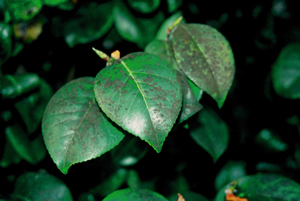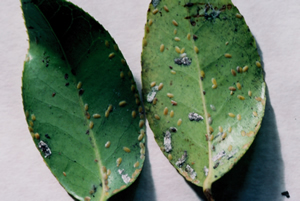|
|
|
Sooty Mould Last Updated: 24/04/2013 |
Black Mould On Camellias If your Camellia leaves are covered by a black, soot-like deposit, this is Sooty Mould.
If your Camellia leaves are covered by a black, soot-like deposit, this is Sooty Mould. Sooty mould is a common condition with camellias and is usually caused by scale insects sucking sap from the underside of the leaves above. Their excreta, 'honey dew' falls on the leaf below - the perfect base for the mould fungus to grow. Many species have more than one generation of young each year, each life cycle can take 10 to 20 weeks, dependent on the time of year and the climate. Colonies may build up faster in warm, humid summers where plants are in shade. All species secrete some form of protective cover under which they live for most of their lives (which makes them more difficult to control). Adult females are wingless and legless once they reach maturity. Adult males are more mobile and, if they are to have them, emerge with wings for a short period during which they mate. Whilst natural predators, such as wrens and tits, will feed on the scale insects, they are unlikely to be able to eradicate a large infestation. The most important thing to do is to eradicate the host problem. Use an insecticide spray to destroy the insects, repeat if necessary. Do this in Summer while they are feeding. It is important to ensure that the undersides of all leaves are treated, so a fairly high volume per square inch is recommended; probably to the point where the liquid runs off the leaf. If your bush is very dense, we recommend thinning the branches by pruning, to allow the treatment to reach all branches. The second treatment is to remove the unsightly deposits from your leaves. There is only one way to achieve this and I'm afraid its a little laborious. Wipe the mould off with a damp sponge. if left alone, the rain will gradually wash it off over a couple of years, provided the insects are destroyed and not allowed to return.
Birds of the Tit family are excellent controllers of insect pests, including scale insects. Bird feeders scattered around the garden encourage their presence. Tags:
sooty mould, black leaves on camellias, why are my camellia leaves turning black, scale insects on camellias, black deposit on camellia leaves, camelia leaves, something is attacking my camellias, camellia leaf problem, gardening problems camelia
|
